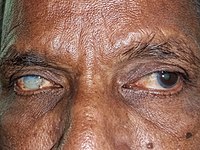
Photo from wikipedia
Purpose: The purpose of this study was to investigate the clinical and genetic features of a man and his daughter with posterior polymorphous corneal dystrophy (PPCD), referred to our clinic… Click to show full abstract
Purpose: The purpose of this study was to investigate the clinical and genetic features of a man and his daughter with posterior polymorphous corneal dystrophy (PPCD), referred to our clinic for Descemet membrane endothelial keratoplasty. No other known relatives were affected. Methods: Ophthalmic examination and histology, including electron microscopy, were performed. Genetic testing was conducted by means of whole exome sequencing, and variant analysis was achieved by using an internal in silico pipeline. Molecular tests included a dual-luciferase assay. Results: Slowly progressive blurred vision was reported from childhood by the daughter. The father's symptoms started at age 55. Best-corrected visual acuity was reduced in both patients (0.2–0.4). Slit-lamp examination in both patients revealed bilateral corneal clouding with gray endothelial lesions; other family members had no ophthalmological signs. Descemet membrane endothelial keratoplasty was performed uneventfully in both patients. Histology showed thickened Descemet membrane and abnormal endothelium resembling epithelial-like cells. Both patients carried the OVOL2 5′ untranslated region NM_021220.4.c.-61G>A variant in the heterozygous state. This change was associated with increased promoter activity and was not present in the unaffected members of the family. Conclusions: The 5′ untranslated region mutation c.-61G>A in OVOL2 has been previously found in 1 individual with PPCD1 and reported as a variant of unknown significance because of insufficient evidence supporting its pathogenicity. Identification of the second family with 2 individuals affected by PPCD1 carrying this change, together with functional data, provides further proofs that it is disease-causing.
Journal Title: Cornea
Year Published: 2021
Link to full text (if available)
Share on Social Media: Sign Up to like & get
recommendations!